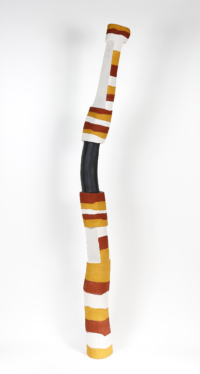Exhibition
Kayimwagakimi – Kaye Brown and Michelle Woody Minnapinni
Where
Outstation Gallery8 Parap Place
Parap, 0820
Darwin, Northern Territory

Art Centres
This exhibition is brought to you by Outstation, in collaboration with the following art centres:
Artists
- Kaye Brown
- Lorraine Kabbindi White
- Michelle Woody Minnapinni
From parlingarri (old days) to ningani (today), Tiwi preparing for the significant Pukumani (mourning) and Kulama (coming of age) ceremonies are painted with jilamara (body paint designs) using a kayimwagakimi (comb).
Kayimwagakimi is a comb carved from ironwood, with a straight row of teeth that when dipped in ochre paint creates finely dotted lines across a surface. The use of this painting comb has been passed down across generations of Tiwi. It is the tool of choice for the important Tiwi culture women Kaye Brown and Michelle Woody Minnapinni.
Both women were taught to use the kayimwagakimi with precision and care by their wulimawi (old people). Michelle remembers ‘my ancestors used the comb’, while Kaye recalls ‘sitting down with old people’ to learn. They now carry on this technique with their own strength and style.
In this exhibition Kayimwagakimi, Kaye and Michelle are ‘sharing ideas, sharing stories together’. Their artworks celebrate the interconnectedness of Murrakupupuni (Country)
and the cultural practices they continue.
Kaye shares a suite of barks dedicated to yirrinkiripwoja (body paint design). She paints almost exclusively with the kayimwagakimi (comb) and does so ‘to keep it going’.
Her paintings transfer jilamara from the skin of the human body to the skin – or bark – of
the local stringybark tree. The bark becomes a carrier of the knowledge, song and yoyi (dance) that accompanies jilamara.
On a black background, Kaye uses a kayimwagakimi to create layers of ochre in shifting shades of red, yellow, and white. In some works, Kaye uses the comb to create plots or bands of colour; other works she applies ochres in countless layers to create a haze of delicate dots. Whether neatly laid out or densely packed, these overlapping dots seemingly shimmer and evoke the energy and movement of ceremonies.
The rhythms of ceremony are also present in Michelle Woody Minnapinni’s paintings and tutini or Pukumani poles. Focusing on kayimwagakimi jilamara (comb body design), Michelle has created works that stretch across diptych and triptych arrangements. These multi-panelled works are large, magnifying kayimwagakimi jilamara beyond its usual scale when painted on the body. Each panel features fluid sections of background colour that flow across the canvases. Using the kayimwagakimi, Michelle adds layers of crosshatched dotted lines to each section choosing to paint these lines in contrasting colours: painting black over and under yellow or pairing red with white. Her use of scale, form and colour expands the jilamara beyond the human body, creating a landscape of energy and motion.
These works are accompanied by Michelle’s first showing of tutini or Pukumani poles. This inaugural presentation marks an exciting new chapter in her practice.
The Pukumani (mourning) ceremony is a significant ceremony for all Tiwi and honours the dead through song and yoyi (dance). Pukumani poles created for the ceremony are placed on the graves of the deceased. Following the ceremony, they remain as a marker until they naturally disintegrate from exposure. Tutini created for exhibition are different from those created for ceremonies.
Michelle’s tutini are painted with ochre paint she prepares herself. Collecting ochre from Murrakupupuni (Country), Michelle handmakes her palette of red, yellow, white and black. The vivid and bold bands of ochre she paints around the tutini differ from her intricate comb work, showing her versatility as an artist.
Michelle and Kaye’s works throw into focus how Murrakupupuni (Country) is embedded in every part of Tiwi cultural and artistic practices. Their combs, the surfaces they paint, the paint they use, are all provided by their island home. Michelle and Kaye’s artworks speak through and with their Murrakupupuni (Country).
Kayimwagakimi showcases the skill, knowledge and individual styles of Kaye Brown and Michelle Woody Minnapinni. Their use of the time-honoured painting comb leads the way for future Tiwi. Kaye and Michelle are both aware of their legacy: ‘when we go on, the young ones will be the next generation’.
Rebekah Raymond




















